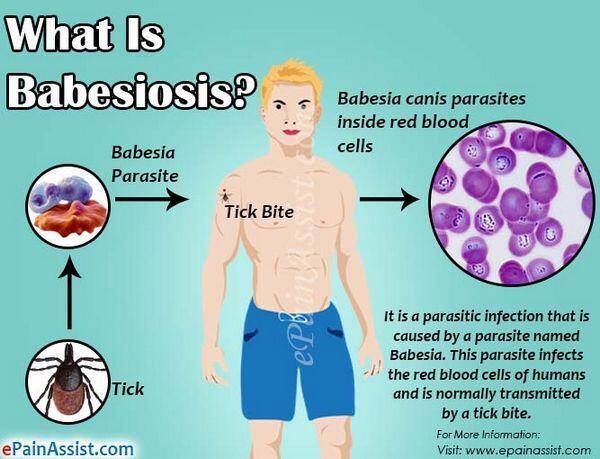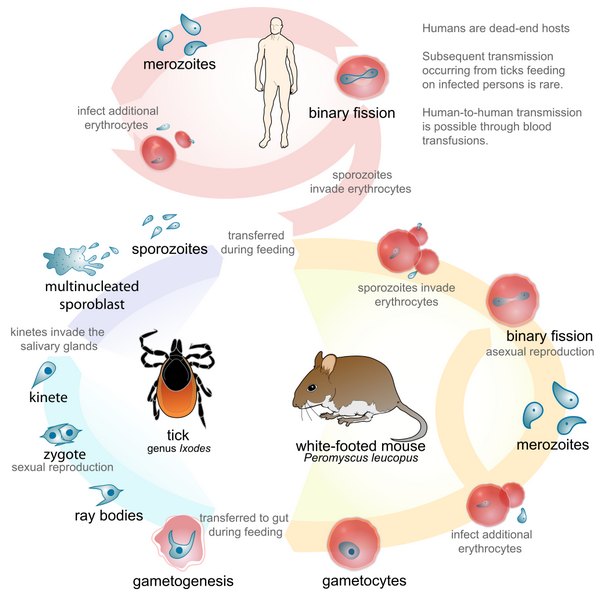Description of Medical Condition
- Babesiosis is a worldwide tick-borne hemolytic disease that is caused by intraerythrocytic protozoan parasites of the genus Babesia
- Babesiosis has rarely been reported outside the US. Sporadic cases have been reported from a number of countries including France, Italy, the former Yugoslavia. United Kingdom, Ireland, the former Soviet Union and Mexico. In the US, infections have been reported from many states but the most endemic areas are the islands off the coast of Massachusetts (including Nan-tucket and Martha’s Vineyard) and New York (including eastern and south central Long Island, Shelter Island and Fire Island) and in Connecticut. In these areas, asymptomatic human infection seems to be common.
- After a recognized tick bite, the incubation period of babesiosis varies from 5-33 days. However, most patients do not recall recent tick exposure. After an infected blood transfusion, the incubation period can be up to nine weeks.

System(s) affected: Pulmonary, Cardiovascular, Renal/Urologic, Hemic/Lymphatic/lmmunologic, Gastrointestinal, Musculoskeletal, Nervous
Genetics: N/A
Incidence/Prevalence in USA:
- Between 1968 and 1993, > 450 Babesia infections were confirmed in the US by blood smears or serologic testing. Prevalence is difficult to estimate because of lack of surveillance, and because infections are often asymptomatic.
- A recent study evaluated the seroprevalence and seroconversion for tick-borne diseases in a high-risk population in the northeast United States. In this one-year seroconversion study of patients in New York state who were at high risk for tick-borne diseases, antibodies to B. microti were seen in seven of 671 participants (1 percent).
Predominant age: All ages; most patients present in their 40s or 50s
Predominant sex: N/A
Medical Symptoms and Signs of Disease
- Asymptomatic
- High fever (up to 40°C[104°F])
- Chills
- Diaphoresis
- Gastrointestinal (anorexia, nausea, abdominal pain, vomiting, diarrhea)
- Generalized weakness
- Fatigue
- Myalgia
- Respiratory (cough, shortness of breath)
- Headache
- Hepatomegaly and splenomegaly or evidence of shock
- Rash (uncommon)
- Central nervous system involvement includes headache, photophobia, neck and back stiffness, altered sensorium and emotional lability
- Jaundice and dark urine may develop later in course of illness
What Causes Disease?
- Babesia microti (in the US) and Babesia divergens and Babesia bovis (in Europe) cause most infections in humans. Recently, one case of 6. divergens was reported in the U.S.
- A previously unknown species of Babesia (WA-1) was isolated from an immunocompetent man in Washington state who had clinical babesiosis. Researchers also described another probable new babesial species (M01) associated with the first reported case of babesiosis acquired in the state of Missouri. M01 is probably distinct from B. divergens but the two share morphologic, antigenic and genetic characteristics.
- Ixodid (or hard-bodied) ticks, in particular Ixodes dammini (Ixodes scapularis) and Ixodes ricinus, are the vectors of the parasite
Risk Factors
- Exposure to endemic areas
- Transfusion-associated babesiosis and transplacental/ perinatal transmission have been reported

Diagnosis of Disease
Differential Diagnosis
- Bacterial sepsis
- Hepatitis
- Lyme disease
- Ehrlichiosis
- Leishmaniasis
- Malaria
Laboratory
- Mild to severe hemolytic anemia (common nonspecific finding)
- Normal to slightly depressed leukocyte count (common nonspecific finding)
- Typical morphologic picture on the blood smear
- A Wright- or Giemsa-stained peripheral blood smear is most commonly used to demonstrate the presence of intraerythrocytic parasites
- Rarely, tetrads of merozoites are visible
- Serologic evaluation with the indirect immunofluores-cent antibody test with use of B. microti antigen is available in a few laboratories. The cutoff titerfor determination of a positive result varies with the particular laboratory protocol used, but in most laboratories, titers of more than 1:64 are considered consistent with 6. microti infection. Tenfold to 20-fold higher titers can be observed in the acute setting, with a gradual decline over weeks to months. The correlation between the level of the titer and the severity of symptoms is poor.
- Detection of B. microti by polymerase chain reaction (PCR) is more sensitive and equally specific for the diagnosis of acute cases, in comparison with direct smear examination and hamster inoculation. PCR-based methods may also be indicated for monitoring of the infection.
Drugs that may alter lab results: N/A
Disorders that may alter lab results: N/A
Pathological Findings
N/A
Diagnostic Procedures
Based on typical morphologic picture on the blood smear in conjunction with epidemiologic information
Treatment (Medical Therapy)
Appropriate Health Care
Outpatient or inpatient depending on symptoms
General Measures
Supportive care
Activity
N/A
Patient Education
AAFP — patient handout — www.aafp.org/afp/20010515/1976ph.html
Medications (Drugs, Medicines)
Drug(s) of Choice
- Atovaquone (Mepron) suspension 750 mg twice daily plus azithromycin (Zithromax) 500-1,000 mg per day
- Combination of quinine (Quinamm) 650 mg of salt orally, three times daily and clindamycin (Cleocin) 600 mg orally, three times daily, or 1.2 g parenterally, twice daily for 7-10 days is the most commonly used treatment. The pediatric dosage is 20-40 mg/kg per day for quinine and 25 mg/kg per day for clindamycin.
- In areas endemic for Lyme disease and ehrlichiosis — may be advisable to add doxycycline (Vibramycin) 100 mg twice a day by mouth in the management of patients with babesiosis until serologic testing is completed
- Exchange transfusion, together with antibabesial chemotherapy, may be necessary in critically ill patients. This treatment is usually reserved for patients who are extremely ill — with blood parasitemia of more than 10 percent, massive hemolysis and asplenia.
Contraindications: N/A
Precautions: Clindamycin can lead to C. difficile associated diarrhea
Significant possible interactions: N/A
Alternative Drugs
Several other drugs have been evaluated, including tetracycline, primaquine, sulfadiazine (Microsulfon) and pyrimethamine (Fansidar). Results have varied. Pentamidine (Pentam) has proved to be moderately effective in diminishing symptoms and decreasing parasitemia.
Patient Monitoring
Monitor for complications (congestive heart failure, etc.) and follow parasitemia as needed
Prevention / Avoidance
- Avoid endemic regions during the peak transmission months of May through September (especially relevant for asplenic or immunocompromised persons in whom babesiosis can be a devastating illness).
- Using insect repellant is advised during outdoor activities, especially in wooded or grassy areas. Products with 10 to 35 percent DEET will provide adequate protection under most conditions.
- Early removal of ticks is important; the tick must remain attached for at least 24 hours before the transmission of B. microti occurs. Daily self-examination is recommended for persons who engage in outdoor activities in endemic areas.
- Pets must be examined for ticks because they may carry ticks into the home
Possible Complications
- Congestive heart failure
- Disseminated intravascular coagulation
- Acute respiratory distress syndrome (that can occur even a few days after the onset of effective antimicrobial treatment)
- Renal failure and myocardial infarction also have been associated with severe babesiosis
Expected Course / Prognosis
- When left untreated, silent babesial infection may persist for months or even years
- 139 hospitalized cases in New York state between 1982 and 1993
- Nine patients (6.5 percent) died
- One fourth of the patients were admitted to the intensive care unit
- One fourth of the patients required hospitalization for more than 14 days
- Alkaline phosphatase levels greater than 125 U per L, white blood cell counts greater than 5 X109 per L history of cardiac abnormality, history of splenectomy, presence of heart murmur and parasitemia values of 4 percent or higher were associated with disease severity
Miscellaneous
Associated Conditions
- Co-infection with Borrelia burgdorferi and 6. Microti is relatively common in endemic areas
- Co-infection with Ehrlichia species may also be seen. Three species of Ehrlichia have been described that infect humans, Ehrlichia chaffeensis, Ehrlichia phagocytophila and Ehrlichia ewingii. Typically, patients have a nonspecific febrile illness. Rash is uncommon with human granulocytic ehrlichiosis but common with human monocytic ehrlichiosis. Laboratory findings often include leukopenia, thrombocytopenia and increases in serum hepatic enzyme activities.
Age-Related Factors
Pediatric: N/A
Geriatric: The morbidity and mortality is higher in patients older than 65
Others: High-level parasitemia is more common in asplenic patients. Such patients have been treated successfully with exchange transfusion in addition to drugs.
Pregnancy
N/A
International Classification of Diseases
088.82 Babesiosis
See Also
Lyme disease




